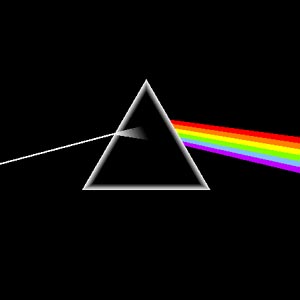
Released this month in 1973, ‘Dark Side Of The Moon‘ remains one of the most enduringly popular albums ever. Here’s our look at the legendary album:
Pink Floyd convened inside Abbey Road studios in the summer of 1972 as a band reinvented. Having replaced key member Syd Barrett with Dave Gilmour four years earlier, the band had first re-grouped and then moved away from the acid leanings of the Barrett-led era, entering a period of their career which many would later look back on as one of the most creative and influential of all time.

Barrett-era Pink Floyd
During the sixties, Pink Floyd had been at the forefront of the psychedelic movement, releasing a clutch of classic singles such as ‘See Emily Play‘ and ‘Arnold Layne‘. However, by the time the group’s second album ‘A Saucerful Of Secrets‘ arrived in June 1968, Barrett had left Pink Floyd; the band citing erratic behaviour and excessive use of drugs as the reason for the departure of their creative driving force.
As the band released ‘Atom Heart Mother‘ in 1970, their gradual change of direction was becoming apparent, but they struggled to gain any genuine critical acclaim during this period. It wasn’t until the release of ‘Meddle‘ in October 1971 that they truly began to find their feet, moving into a domain which would soon become known as Progressive Rock. With all the band contributing new ideas in the studio ‘Meddle’ showed to the world that Pink Floyd had a future, and even though reviews remained mixed, the sound and mind-set which would see Pink Floyd become one of the biggest bands in the world was well underway; it was undoubtedly ‘Meddle’ which pointed the way to ‘Dark Side Of The Moon‘.
The first seeds of ‘Dark Side…’ were sown when the group began tentative rehearsals in a Bermondsey studio borrowed from the Rolling Stones. As Roger Waters would later recall, the sessions were relaxed to say the least, but despite the laid-back approach, the wheels for Pink Floyd’s next studio album had been set in motion. After the foundations had been laid, the band moved on for more rehearsals at the Rainbow Theatre, and subsequently took their new work out on the road before taking it permanently into the studio.

Abbey Road studios
As with the trend set on their previous LPs, when work began on new material at Abbey Road it was very much a collaborative effort. All members contributed to a desire to explore new sounds and methods of recording. The pattern of experimentation mirrored the work done by The Beatles in the same studios during the ‘Sgt.Pepper…‘ sessions five years previously and, as with that record, there was a collective will to try new things, to push boundaries and to make use of everything that became available in the studio.
The band’s plan to have a central idea running through the record also echoed the efforts of The Beatles, or more accurately Paul McCartney, whilst recording ‘Sgt. Pepper’s Lonely Hearts Club Band‘. But unlike The Beatles, Pink Floyd pressed on, and the unified themes running throughout the album – an idea first mooted by Roger Waters in the earliest meetings regarding the new LP – make it one of the first fully realised concept records.
Recording began on the 1st of June with ‘Us and Them‘, and it soon became clear that virtually nothing was off limits as Floyd chased the sound they wanted. So it was that Roger Waters used recordings of him throwing coins into a food mixing bowl on ‘Money‘, while the band and engineers spent hours getting clocks to chime in sequence while recording ‘Time‘. Use of synthesizers and other early electronic equipment also dominated the sessions, and became a prominent part of the resultant album.
After a break, the bandmates returned to the studio in January 1973 for more sessions. During this final period, four female vocalists – Doris Troy, Lesley Duncan, Liza Strike and Barry St.John – were signed up, laying down backing vocals on ‘Brain Damage‘, ‘Eclipse‘ and ‘Time‘. Alongside Clare Torry’s improvised take which dominates ‘The Great Gig In The Sky‘, the singers added more layers to the LP and, together with the famous harmonising and double-tracking of Richard Wright and Dave Glimour’s, helped to give the album its distinctive rich quality.
‘Dark Side Of The Moon’s iconic status was further enhanced by the choice of sleeve, one of the most recognisable in history. Under strict instructions from the band to produce something ‘smarter’ than their previous efforts, the group’s long-term art design team Hipgnosis were again picked to work on the packaging. One of the group’s members, Storm Thorgerson, is credited with the famous Prism design, after being inspired by a photograph he had been shown during discussions regarding the artwork. In the end, Pink Floyd were presented with seven ideas for the album’s cover, and all were immediately unanimous in their final choice. With the songs, production and now brilliant sleeve design all finished, ‘Dark Side Of The Moon’ was ready to hit the shelves.

The ‘classic’ Pink Floyd line-up: (l-r) Nick Mason, Dave Gilmour, Roger Waters, Richard Wright
With much stronger support from their record label, ‘Dark Side Of The Moon’ was released initially in the US and later in the UK to a much more positive response from critics, and became an immediate smash hit. It went Gold in the UK shortly after its release, and hit the top spot in the US just over a month later. As Capitol Records continued to push in the US, backed by radio-edits of ‘Us and Them’ and ‘Time’ – as well as brilliantly distinctive, acerbic bass-led single ‘Money‘ which showcased the quirkiness of the album perfectly – the units continued to pile up. Famously, the album went on to spend an incredible 741 weeks on the Billboard Top 200, and is now one of the best selling of all time with total world-wide sales estimated at over 45 million.
As the accolades continued to flood in, the four members of Pink Floyd began to feel uneasy with their runaway success; a mood which would be addressed on the 1975 follow-up ‘Wish You Were Here‘. Indeed, they would have a constant struggle coming to terms with their sudden world-wide fame and commercial status. Later, Richard Wright would recall his thoughts on the record’s achievements:
“…the only criterion we have about releasing music is whether we like it or not. It was not a deliberate attempt to make a commercial album. It just happened that way. We knew it had a lot more melody than previous Floyd albums, and there was a concept that ran all through it. The music was easier to absorb and having girls singing away added a commercial touch that none of our records had.”
Released at the height of Glam Rock, ‘Dark Side Of The Moon’ brought so-called Prog into the mainstream and ushered in an era of huge experimentation – and ultimately over-indulgence – from a succession of bands throughout the seventies. When the Prog Rock-era is looked back on today, it’s clear one of the triumphs of ‘Dark Side Of The Moon’ is it’s careful ability to stay on the right side of the line, full experimentalism and heavy themes without slipping into the over-blown, self-gratifying state which would later swamp the genre, always keeping a close eye on the basic requirements of quality and melody. These are ideals which were quickly lost on their peers, and which would lead to the explosion of Punk just four years after ‘Dark Side…‘, when young bucks in homemade ‘I Hate Pink Floyd’ t-shirts rebelled against the bloated state of Prog by replacing 30-minute keyboard solos with 30-minute LPs.
With ‘Dark Side Of The Moon’, Pink Floyd achieved that very rare feat – marrying innovation and creativity in the studio with phenomenal commercial success.
It’s a combination which makes this album one of the great success stories in rock history.
(Dave Smith)




Awesome review of an awesome album. I’m in my 50s now and my kids cringe when I tell them this was the perfect LP for getting stoned. Funny thing is, they know what “getting stoned” means but they’re unsure what an LP is! Thanx again.
A nice review, thanks. The very first seeds were sown just before Bermondsey, with the Floyd just back from their latest ’71 tour of Meddle finishing at the end of November that year. The next UK tour was planned for January, so there were 6 weeks to create new material – there was pressure for new live material and another recorded album. Immediately upon return to the UK, a meeting at Nick Mason’s house in Camden was followed by a stint at the Decca Studios Islington, before the 2 weeks in Bermondsey, and 3 nights at the Rainbow Theatre for final rehearsals of the new material and a new PA system. Eclipse, as it was know at first, was ready for the road, fine tuned over the course of the next 12 months, and finallly released as The Dark Side Of The Moon, which remains a classic 40 years on – time to celebrate it’s birthday. AL